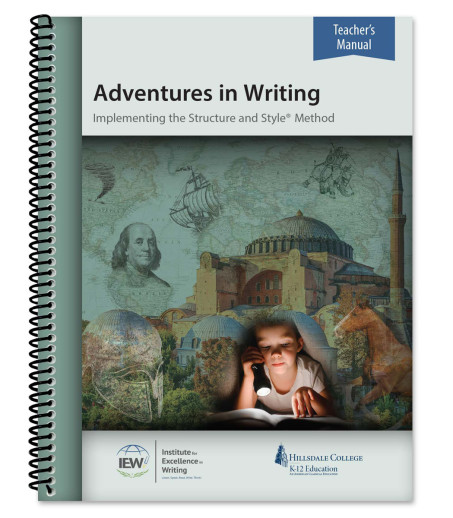We use cookies to make your experience better. To comply with the new e-Privacy directive, we need to ask for your consent to set the cookies. Learn more.
Adventures in Writing Teacher's Manual
This teacher book provides brief video summaries, the student book in small-format, additional teaching information, notes from Pudewa’s teaching lessons, answers (when applicable), and more. The teaching follows a pick-up-and-go approach—as long as you have learned the methodology of and have access to the IEW program, Teaching Writing: Structure and Style. Concise directions for reading, discussing, engaging in assignments; vocabulary; assignment checklists; and more are found in the margins. Sample writings and specific answers are provided.
I appreciate the rubric-style grading checklists provided at the end of each lesson. Each checklist will include elements the students are familiar with, plus one new element, with points given for such things as the student’s composition structure, mechanics, vocabulary, etc. If students aren’t ready for one of the checklist elements, you have the freedom to remove it and add it back in as the child’s skills develop. Additional appendixes include mechanics overview, a vocabulary chart with words and definitions for each lesson, review games, and suggested literature. Reading selections pull from Aladdin and Other Favorite Arabian Nights Stories; Benjamin Franklin; Black Beauty; famous Greek/Roman/Norse myths; The Princess and the Goblin; Farmer Boy; The Jungle Book; and multiple excerpts from What Your Third Grader Needs to Know. The accompanying PDF downloads are available for free with the purchase of this book (instructions included in text). Nonreproducible, 252 pgs, spiral-bound, pb. ~ Ruth
Based on specific topics or on events in history, these sets of writing lessons (same grade-range levels as the SSS) offer comprehensive, almost scripted instruction. All necessary source texts have been developed for busy parents and teachers like you. An IEW veteran and aficionado myself, I couldn't conceive of anything more complete than what is provided here. Each lesson offers comprehensive (just short of totally scripted) instruction. All necessary source texts are provided and are reproducible for one parent/one homeschool. Clear assignments (sometimes differentiated between levels) along with a checklist to aid both the student in preparation and the parent in grading. These are also designed to be used by the student to work on throughout the week. Based on specific topics or events in various segments of history, the lessons include grammar exercises, vocabulary development, quizzes, and games for review and reinforcement - along with the writing instruction, of course.
In all lessons students are encouraged to polish their final draft perhaps even adding illustrations. At the end of each course the student will have a personal portfolio collection of poems, stories, reports, essays and research papers. Lessons are taught at the beginning of each week allowing the rest of the week for students to complete the assignment which they should be able to do on their own. Teacher preparation is minimal. (Do I hear an emphatic "Yes!"?)
The courses are targeting a progressively more competent student with the assumption that students are working through the courses according to suggested grade levels. Therefore, there is an increasing complexity to the instructions, expectations, and assignments. Accordingly, teachers are encouraged to be flexible with plans. The beginning writer may need to spend more than the suggested week on difficult lessons or omit some of the grammar. Mature students may move more quickly to allow time for additional research writing and/or more creative essay writing.
Many of these courses can be used equally well within a homeschool with several different aged students and all can be used in a co-op/support school setting with more grade-specific groupings of students. It's assumed that parents/teachers have completed Teaching Writing Structure & Style (TWSS), IEW's DVD seminar for parents and teachers.
Some courses have both a Teacher and a Student Book. In these courses, instruction for the teacher is more extensive and both books are necessary as the course is designed to be interactive between the teacher and student. Teachers should plan to read over the lessons with the students and help as necessary, especially with outlining and brainstorming. A roll of tickets (available at office supply stores) is optional but very useful for encouragement and motivation. ~ Janice
This multi themed-based writing program allows students to venture into varied topics of history and science as they hone their writing skills. Explore source texts on themes from the Nile to tornadoes, magnets to dolphins, the Nile to the Colosseum, Leif Eriksson to Roanoke, and more. Students will learn and practice how to write from notes, retell narratives, summarize references, write from pictures, summarize multiple references, and inventive writing. A list of suggested literature helps tie in themes (See Teacher book description for a detailed list). This curriculum assumes teachers have learned the methodology of and have access to the IEW program, Teaching Writing: Structure and Style, which will be referenced in each unit. The thirty lessons also introduce vocabulary which is practiced regularly, with periodic quizzes, and the goal of incorporating these words in their writing. Students learn words like melodious, colossal, commotion, nutritious, and spacious (with 5 possible quizzes for review). To teach the course, purchase the combo, or as individual pieces. For more information, see the individual item descriptions.
This course is the first in a series of multi-theme courses created in conjunction with Hillsdale’s K-12 topics of scope and sequence, which assigns a Grade 3 reading level to this course. See Discoveries in Writing sku 014431 for volume 2 in this series. ~ Ruth
| Product Format: | Paperback |
|---|---|
| Brand: | Institute for Excellence in Writing |
| Grades: | 3-5 |
| ISBN: | 9781623414047 |
| Length in Inches: | 11 |
| Width in Inches: | 9 |
| Height in Inches: | 0.875 |
| Weight in Pounds: | 1.35 |

